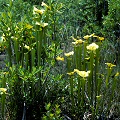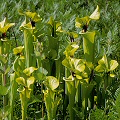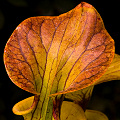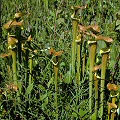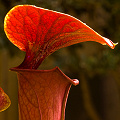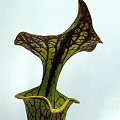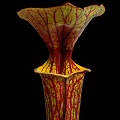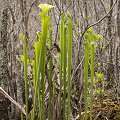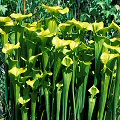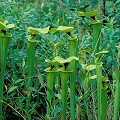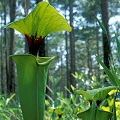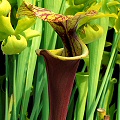Q: About Sarracenia flava, the yellow pitcher plant
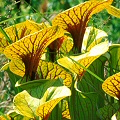
Virginia infravarietal
A: Sarracenia flava is probably the grandest species of the
genus. Yes, there is no doubt that the sluttish Sarracenia leucophylla can certainly be exceptionally
gaudy, but Sarracenia flava is a regal beauty that has poise that the slatternly
S. leucophylla can only dream about.
If you have a problem with pronouncing Sarracenia flava, you may call this plant the
yellow pitcher plant because "flava" is Latin for yellow.
Sarracenia flava is a tall, slender trumpet pitcher that can easily be more than a meter tall. The
mouth of the pitcher is circled by a conspicuous, outward-rolled lip. This lip usually dips at the front, as if it were a
pouring spout. The column that attaches the back of the pitcher to the lid is tall, and recurved back at the edges. The lid is
usually very large and either flat or flaring upwards at the margins. The front of the lid has a little tendril-like tip that
twiddles out in the air. (I mention these details, in part, to contrast with the similar
Sarracenia oreophila to be discussed in a few FAQ pages.)
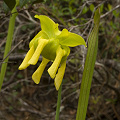 Sarracenia flava flowers are large, with long and straplike dangling yellow petals. They are
famous for having a strong, cat-pee smell. Yum yum! If you bring a warm plant that has been growing in full sun and is bearing
many flowers indoors, you can stink up an entire room.
Sarracenia flava flowers are large, with long and straplike dangling yellow petals. They are
famous for having a strong, cat-pee smell. Yum yum! If you bring a warm plant that has been growing in full sun and is bearing
many flowers indoors, you can stink up an entire room.
In cultivation, Sarracenia flava seems to put all its growing efforts into a few pitchers
at the beginning of the year. After these pitchers are made, few further pitchers are produced.
During the winter, Sarracenia flava produces tall sword-shaped leaves lacking pitchers,
called phyllodia. These allow the plant to photosynthesize all winter, during which there are fewer bugs to hunt.
Range
States: Alabama, Florida, Georgia, North and South Carolina, Virginia.
Comments about each variety are given below. The species, in general, is most threatened by habitat destruction.
Varieties
There are seven varieties of Sarracenia flava, but these are mostly variations in the
pitcher coloration. The truth is that for the most part, plants in the field
will have characteristics of more than one of the varieties. Indeed, crosses between these varieties often
dominate the populations at some sites. For example, the Virginia plant at the top of this page looks like it may be an intergrade between
Sarracenia flava var. rugelii and S. flava var.
ornata. Do not spend too much time trying to analyze S. flava
plants: you will go insane.
Sarracenia flava var. atropurpurea (Hort. Bull) Bell
This is an unmistakable plant
that is deep red over the entire pitcher tube and lid.
It is most common in the Atlantic coastal plain in the Carolinas, where even there it is rare. It also
occurs in the Florida panhandle, but is very rare there as well. It is sometimes referred to as
Sarracenia flava "all-red" in older publications. In order to obtain the intense coloration, this plant needs a great deal of light. Some
clones are very picky, and if transplanted or even moved, they may lose their coloration for the season. I had one plant that
maintained its coloration only if I never even rotated its pot during the growing season. This mystifies me.
Sarracenia flava var. cuprea Schnell
This variety is marked by a
reddish or copper lid contrasting with a green pitcher tube. The copper lids on some clones tend to
fade later in the season, but this is not
the case with all plants of this variety. It is most common in the Carolinas, but it can occur in northwestern Florida.
Sarracenia flava L. var. flava
This plant has a red
throat patch caused by a concentration of veining. Various amounts of veining can occur elsewhere on the plant,
but it is never a dominant feature
of the plant's appearance. This variety is very common along the Atlantic plain (especially the Carolinas) but rare in Virginia.
It is sometimes referred to as
Sarracenia flava "typica" in older publications.
An anthocyanin-free variant has been detected and is called
Sarracenia flava f. viridescens.
Sarracenia flava var. maxima Hort. Bull ex Mast.
Despite
the "maxima" name, this is a normal-size plant. The leaves lack any kind of red coloration,
although anthocyanin is present in young leaves. This uncommon variety is most likely to be encountered in the
Carolinas, but it may appear in northwestern Florida as well. This wild variety is not to be confused with the horticultural
selection of an anthocyanin-free plant, which is called Sarracenia flava 'Suspicion.'
Sarracenia flava var. ornata Hort. Bull ex Mast.
This plant has a
red throat patch, and intense venation all over the pitcher tube and
lid of this plant. This is the origin for the old horticultural name "heavily-veined". In some plants, secondary veins connect the
vertical veins, and such plants may become almost completely red as
the season progresses, approaching Sarracenia flava var. atropurpurea
in color. Other plants lack a throat patch but make up for this with ornate venation.
My favorite plants are those with intense vertical veins only; such plants may be "candy-striped" and
look really great! Sarracenia flava var. ornata is most common in the
Carolinas but may occur in northwestern Florida.
Sarracenia flava var. rubricorpora Schnell
This plant has a red
tube, with the lid veined and either yellow or green. This plant is very beautiful, but unfortunately usually only produces a
single large pitcher per rosette each year, so fields of this variety are somewhat sparsely pitchered. A rare plant, it is
only found in the Florida panhandle.
Sarracenia flava var. rugelii (Shuttlew. ex A.DC.) Mast.
A big
lid, a red or purple throat patch, and no red pitcher or tube venation
characterise this variety. This plant is the dominant variety of the species in southern Georgia and westward to the
Florida panhandle. It is an excellent plant in cultivation because it produces several pitcher per rosette each year,
resulting in densely clustered sets of pitchers. This has often been confused in publication by many (including myself)
with S. f. var. maxima, but there is no longer any excuse for this
since Schnell clarified the nomenclature in 1998.
Page citations:
Kartesz, J. et al. 2009 (BONAP); McDaniel, S. 1971; McPherson, S. 2006;
McPherson, S. & Schnell, D. 2011; Rice, B.A. 2006a;
Schnell, D., 1998, 2002a; personal observations.
